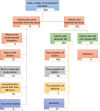Frequency and types of antibiotic usage in a referral neonatal intensive care unit, based on the world health organization classification (AwaRe)
- PMID: 39856585
- PMCID: PMC11759425
- DOI: 10.1186/s12887-025-05407-z
Frequency and types of antibiotic usage in a referral neonatal intensive care unit, based on the world health organization classification (AwaRe)
Abstract
Background: Excessive prescription of antibiotics in infants increases the risk of short-term and lifelong morbidity and mortality. Nonetheless, the use of antibiotics in neonatal intensive care units (NICUs) is significantly high. This is primarily because neonatologists are concerned about the fragile immune systems of newborns, their vulnerability to serious infectious diseases, and the challenge of accurately distinguishing between infectious and non-infectious conditions.
Method: A five-month cross-sectional prospective study was conducted in southwestern Iran's largest neonatal intensive care unit. This study aimed to evaluate the dose and duration of antibiotic therapy and identify the prescribing pattern of antibiotics based on the Access, Watch, and Reserve (AWaRe) classification recommended by the World Health Organization (WHO).
Results: Out of 502 examined patient files, antibiotics were prescribed for 483 neonates. The most common drug combinations were ampicillin and amikacin. The mean number and duration of antibiotic administration were 2.14 drugs and 7.78 days, respectively. 84.3% of infants received antibiotics for ten days or less. The mean course of antibiotic prescription for newborns was 1.1, and 83.1% of prescribed antibiotics were from the Access Group.
Conclusion: The antibiotic prescription rate was high in our study's department. Most neonates received two antibiotics in one course from the Access group.
Keywords: Antibiotics; Aware; Iran; Neonates.
© 2025. The Author(s).
Conflict of interest statement
Declarations. Ethics approval and consent to participate: The research was conducted with the approval of the Pediatrics Department and the Research Vice-Chancellor of Ahvaz University of Medical Sciences and in accordance with the World Medical Association Declaration of Helsinki. The data for this study was obtained from the patient’s hospital records immediately following their discharge. No diagnostic or therapeutic interventions were conducted during their hospital stays, and all patients’ personal information was kept entirely confidential. Written informed consent was obtained from the legal guardians before the neonate was enrolled. The Medical Ethics Committee of Ahvaz Jundishapur University of Medical Sciences provided the code IR.AJUMS.REC.1403.011 to authorize the initiation of this study. Consent for publication: Not applicable. Competing interests: The authors declare no competing interests.
Figures
Similar articles
-
Up to 89% of neonates received antibiotics in cross-sectional Indian study including those with no infections and unclear diagnoses.Acta Paediatr. 2017 Oct;106(10):1674-1683. doi: 10.1111/apa.13935. Epub 2017 Jun 26. Acta Paediatr. 2017. PMID: 28556272
-
Evaluation of antibiotics in pediatrics using the defined daily doses method and the World Health Organization (WHO) access, watch, and reserve classification (AWaRe 2021): a cross-sectional study.Pan Afr Med J. 2024 Jul 4;48:88. doi: 10.11604/pamj.2024.48.88.36498. eCollection 2024. Pan Afr Med J. 2024. PMID: 39465199 Free PMC article.
-
Pediatric Antibiotic Prescribing in China According to the 2019 World Health Organization Access, Watch, and Reserve (AWaRe) Antibiotic Categories.J Pediatr. 2020 May;220:125-131.e5. doi: 10.1016/j.jpeds.2020.01.044. Epub 2020 Feb 21. J Pediatr. 2020. PMID: 32093934
-
Adverse consequences of neonatal antibiotic exposure.Curr Opin Pediatr. 2016 Apr;28(2):141-9. doi: 10.1097/MOP.0000000000000338. Curr Opin Pediatr. 2016. PMID: 26886785 Free PMC article. Review.
-
Re-Thinking the Norms of Antibiotic Prescribing in the Neonatal Intensive Care Unit.Clin Perinatol. 2025 Mar;52(1):133-146. doi: 10.1016/j.clp.2024.10.009. Epub 2024 Nov 29. Clin Perinatol. 2025. PMID: 39892948 Review.
References
-
- Krzyżaniak N, Pawłowska I, Bajorek B. Review of drug utilization patterns in NICUs worldwide. J Clin Pharm Ther. 2016;41(6):612–20. - PubMed
-
- Clark RH, Bloom BT, Spitzer AR, et al. Reported medication use in the neonatal intensive care unit: data from a large national data set. J Pediatr. 2006;117:1979–87. - PubMed
MeSH terms
Substances
LinkOut - more resources
Full Text Sources
Medical


